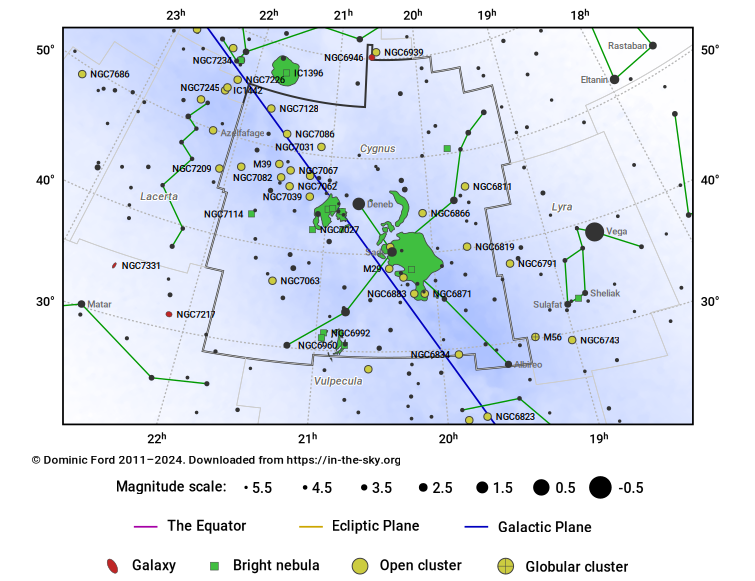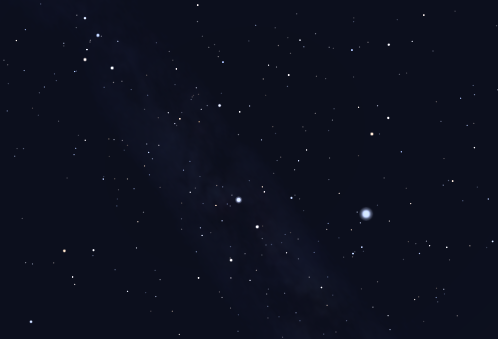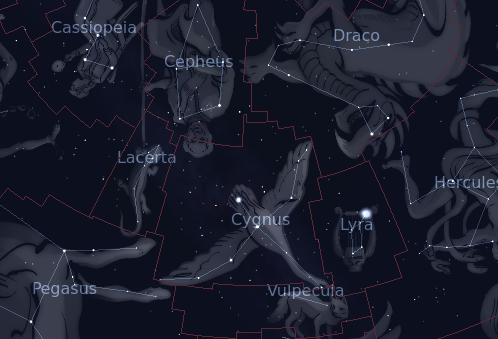The Constellation Cygnus
Cygnus is a large and easily recognisable constellation in the northern summer sky. Its brightest star, Deneb forms one vertex of the Summer Triangle asterism.
Visually, Cygnus appears as a ‘T’-shaped grouping of stars, with a fainter star Albireo (β¹-Cyg) making the T into a cross. For this reason, the asterism is sometimes known as the Northern Cross.
The Milky Way passes through the middle of the cross, littering it with some of the richest star fields in the northern sky. Among these are twenty open clusters of tenth magnitude or brighter. A pair of binoculars are quite sufficient to bring hundreds of stars into view.
The star Albireo (β¹-Cyg) is particularly often observed, as it is a binary whose two components have two strongly contrasting colors – one red and the other blue.
The name ‘Cygnus’ is Latin for ‘swan’, though accounts vary as to the swan's identity. In one popular story, Cygnus is the god Zeus in disguise, pursuing one of his many love interests – perhaps Nemesis or Leda, mother of Helen of Troy.
Ancient
1.9% of the sky
804.0 square degrees
Hover the pointer over the name of an object to highlight its position on the starchart to the right, or click to see more information.
| Stars | Open Clusters | Globular Clusters | Galaxies |
| Deneb (mag 1.3) | Messier 39 (mag 4.6) | NGC 6946 (mag 9.7) | |
| Sadr (mag 2.2) | NGC 6871 (mag 5.2) | NGC 7013 (mag 11.3) | |
| Gamma Cygni Nebula (mag 2.2) | Messier 29 (mag 6.6) | NGC 6824 (mag 11.8) | |
| ε-Cyg (mag 2.5) | NGC 6811 (mag 6.8) | IC 1392 (mag 12.9) | |
| δ-Cyg (mag 2.9) | NGC 7063 (mag 7.0) | IC 1302 (mag 13.3) | |
| NGC7114 (mag 3.0) | NGC 7082 (mag 7.2) | NGC 6764 (mag 13.6) | |
| Albireo (mag 3.1) | NGC 6819 (mag 7.3) | NGC 7116 (mag 14.1) | |
| ζ-Cyg (mag 3.2) | IC 4996 (mag 7.3) | IC 1303 (mag 14.2) | |
| ξ-Cyg (mag 3.7) | NGC 6910 (mag 7.4) | IC 1301 (mag 14.2) | |
| τ-Cyg (mag 3.7) | NGC 7039 (mag 7.6) | NGC 6798 (mag 14.4) | |
| ι-Cyg (mag 3.8) | NGC 6866 (mag 7.6) | NGC 6801 (mag 14.7) | |
| κ-Cyg (mag 3.8) | NGC 6834 (mag 7.8) | NGC 6783 (mag 15.2) | |
| V695 Cyg (mag 3.8) | NGC 6883 (mag 8.0) | NGC 6916 (mag 15.2) | |
| η-Cyg (mag 3.9) | NGC 7062 (mag 8.3) | ||
| ν-Cyg (mag 3.9) | NGC 7086 (mag 8.4) | ||
| ρ-Cyg (mag 4.0) | IC 1369 (mag 8.8) | ||
| V1488 Cyg (mag 4.0) | NGC 7031 (mag 9.1) | ||
| 41-Cyg (mag 4.0) | NGC 7128 (mag 9.7) | ||
| 52-Cyg (mag 4.2) | NGC 7067 (mag 9.7) | ||
| σ-Cyg (mag 4.2) | IC 5146 (mag 10.0) | ||
| π²-Cyg (mag 4.2) | NGC 7044 (mag 12.0) | ||
| 33-Cyg (mag 4.3) | IC 1311 (mag 13.1) | ||
| υ-Cyg (mag 4.4) | NGC 6846 (mag 14.2) | ||
| 39-Cyg (mag 4.4) | NGC 7093 | ||
| θ-Cyg (mag 4.5) | NGC 6832 | ||
| f²-Cyg (mag 4.5) | NGC 6856 | ||
| λ-Cyg (mag 4.6) | IC 1363 | ||
| 47-Cyg (mag 4.7) | NGC 7175 | ||
| Azelfafage (mag 4.7) | NGC 6895 | ||
| β²-Cyg (mag 4.7) | NGC 7127 |




